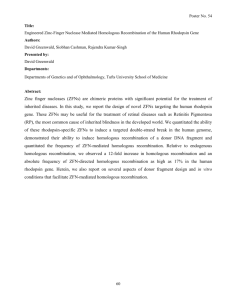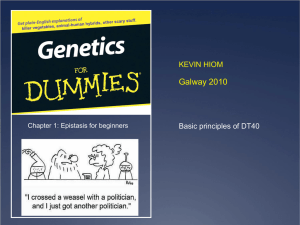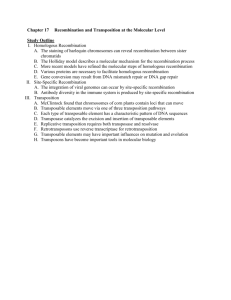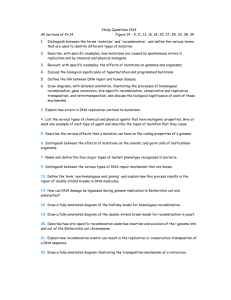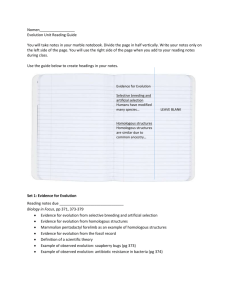DNA double-strand break repair
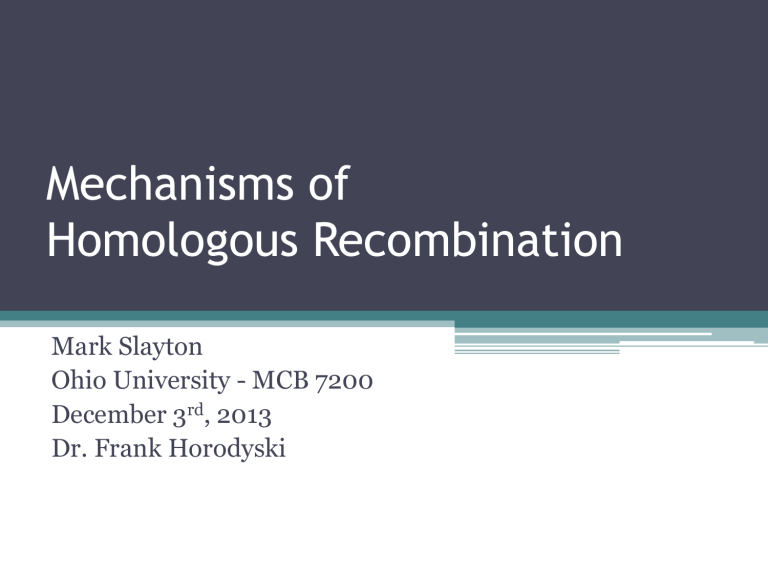
Mechanisms of
Homologous Recombination
Mark Slayton
Ohio University - MCB 7200
December 3 rd , 2013
Dr. Frank Horodyski
Overview
• Background Information
• What is Homologous Recombination?
▫ DNA double-strand break repair
▫ Chromosomal crossover
▫ Horizontal gene transfer
• The RecBCD Pathway
• Homologous Recombination in Eukaryotes
• Practical Applications
Overview
• Background Information
• What is Homologous Recombination?
▫ DNA double-strand break repair
▫ Chromosomal crossover
▫ Horizontal gene transfer
• The RecBCD Pathway
• Homologous Recombination in Eukaryotes
• Practical Applications
Background Information
• The term ‘homologous recombination’ was developed over a series of discoveries demonstrating “non-
Mendelian” genetics
Early 1900’s – traits can be genetically linked
1911 – “crossing-over” can occur between chromosomes
1931 – chromosomal crossover in gametes (meiosis) and in somatic cells (mitosis)
Background Information
1947 –prokaryotic genetic recombination, establishes E. coli as a model organism
1964 – meiotic recombination, Holliday junction
1983 – double-strand break repair (DSBR) pathway
Additional research leads to discovery of a multitude of different pathways for homologous recombination in organisms from all three domains – bacteria, archaea, and eukarya – as well as in viruses
Overview
• Background Information
• What is Homologous Recombination?
▫ DNA double-strand break repair
▫ Chromosomal crossover
▫ Horizontal gene transfer
• The RecBCD Pathway
• Homologous Recombination in Eukaryotes
• Practical Applications
What is Homologous Recombination?
DNA double-strand break repair
• Bacteria primarily employ the
RecBCD pathway (“A”)
• Eukaryotes typically use either double-stranded break repair
(DSBR) or synthesis-dependent strand annealing (SDSA) (“B”)
“Repair of DNA double-strand breaks”, Dale Wigley. www.icr.ac.uk
What is Homologous Recombination?
Chromosomal crossover
• Shuffles alleles and genetic traits to drive evolution, adaptation
• Incorrect rejoining of chromosomes leads to serious problems like Down’s syndrome or miscarriage in humans
(8)
From Classical Genetics – Chapter 9, Fundamentals of
Genetics
What is Homologous Recombination?
Horizontal gene transfer
• Horizontal/lateral gene transfer in bacteria relies on homologous recombination (13)
• Often used for the spread of genes conferring antibiotic resistance as well as virulence factors (12)
From Furuya and Lowy, Nature Reviews Microbiology. 4, 36-45 (2006)
Overview
• Background Information
• What is Homologous Recombination?
▫ DNA double-strand break repair
▫ Chromosomal crossover
▫ Horizontal gene transfer
• The RecBCD Pathway
• Homologous Recombination in Eukaryotes
• Practical Applications
From Cold Spring Harbor Laboratory Press, © 2007.
The RecBCD Pathway
• RecBCD complex binds to the blunt end of DS break
• The complex will pause upon recognizing the Chi site (14)
• 5’-GCTGGTGG-3’
• RecA protein is loaded by RecBCD onto the nicked strand 5’ of the Chi site and the complex disassembles (14)
From Cold Spring Harbor Laboratory Press, © 2007.
The RecBCD Pathway
• DNA/RecA nucleoprotein performs strand invasion on the identified homologous sequence, forming a displacement loop (D-loop) (19)
• Conversion to a Holliday structure leads to repair by crossing over
• Resolution of Holliday structure is carried out by the RuvABC complex.
Electron micrograph of unwinding DNA during RecBCD homologous repair
From Smith, GR. Microbiol. Mol. Biol. Rev. 76:217-228. 2012.
Overview
• Background Information
• What is Homologous Recombination?
▫ DNA double-strand break repair
▫ Chromosomal crossover
▫ Horizontal gene transfer
• The RecBCD Pathway
• Homologous Recombination in Eukaryotes
• Practical Applications
Homologous Recombination in Eukaryotes
• Shortly after a double-strand break occurs, the MRN complex (MRX complex in yeast) initiates repair as described previously (4)
• Leads to formation of 3’ overhangs which are coated in Rad51, the RecA homolog
(4)
• The invading 3’ strand is extended by
DNA synthesis, forming the Holliday structure (22)
Homologous Recombination in Eukaryotes
• In DSBR, the non-invading DNA/Rad51 nucleoprotein is base-paired by the newly synthesized strand (22) and restored by
DNA polymerase/ligase (4)
• Double Holliday structures produced
• In SDSA, only one Holliday structure is formed by the invasion of the nucleoprotein.
• Top strand is synthesized and ligated, resulting in a non-crossover homologous repair (23)
Overview
• Background Information
• What is Homologous Recombination?
▫ DNA double-strand break repair
▫ Chromosomal crossover
▫ Horizontal gene transfer
• The RecBCD Pathway
• Homologous Recombination in Eukaryotes
• Practical Applications
Practical Applications
Drs. Mario Capecchi, Martin Evans, and Oliver Smithies shared the 2007 Nobel Prize in physiology or medicine for developing this technique
From “Gene Modification in Mice” www.nobelprize.org
2007.
References
1.
2.
3.
4.
5.
6.
7.
8.
9.
10.
11.
12.
Li, X. Heyer W.D. Homologous recombination in DNA repair and DNA damage tolerance. Cell Research.
18:99-113. 2008.
Hong, Soogil et al. The Logic and Mechanism of Homologous Recombination Partner Choice. Molecular Cell.
51:440-453. 2013.
Van Gent, Dik et al. Chromosomal stability and the DNA double-stranded break connection. Nature Reviews
Genetics. 2:196-206. 2001.
Horodyski, Frank. MCB 7200 Lecture. Ohio University, Fall 2013.
Alberts, Bruce. “Chapter 6: Homologous Recombination” Essential Cell Biology, 3 rd edition.
Filippo, Joseph, Patrick Sung, and Hannah Klein. Mechanism of Eukaryotic Homologous Recombination.
Annual Reviews in Biochemistry. 77:229-257. 2008.
Haber, James E., Gregorz Ira, Anna Malkova, and Neal Sugawara. Repairing a double-stranded chromosome break by homologus recombination: revisiting Robin Holliday’s model. Phil. Trans. R. Soc. Lond. 359:79-86.
2004.
Thomas-Zucker, Julie. “Chromosomal Crossover how Genetic Exchange Increases Variation” Sciences 360.
March 21, 2012. www.sciences360.com
Francone, Frank D., Markus Conrads, Wolfgang Banzhaf, and Peter Nordin. Homologous Crossover in
Genetic Programming.
Andersson, J.O. Lateral Gene Transfer in Eukaryotes. Cellular and Molecular Life Sciences. 62:1182-1197.
2005.
Lawrence, Jeffrey G. and Adam C. Retchless. The Interplay of Homologous Recombination and Horizontal
Gene Transfer in Bacterial Speciation. Methods of Molecular Biology. 532:29-53. 2009.
Krzywinska, Elzbieta, Jaroslaw Krzywinski and Jeffrey S. Schorey. Naturally occuring horizontal gene transfer and homologous recombination in Mycobacterium. Microbiology. 150:1707-1712. 2004.
References
13.
14.
15.
16.
17.
18.
19.
20.
21.
22.
23.
Thomas, Christopher M. and Kaare M. Nielsen. Mechanisms of, and Barriers to, Horizontal Gene Transfer between Bacteria. Nature Reviews Microbiology. 3:711-721. 2005.
Dillingham, Mark S. and Stephen C. Kowalczykowski. RecBCD Enzyme and the Repair of Double-Stranded
DNA Breaks. Microbiology and Molecular Biology Reviews. 72:642-671. 2008.
Claverys, JP, B. Martin and P. Polard. The genetic transformation machinery: composition, localization, and mechanism. FEMS Micriobiology Reviews. 33:643-656. 2009.
Arbuckle, Jesse H. and Peter G. Medveczky. The molecular biology of human herpesvirus-6 latency and telomere integration. Microbes and Infection. 13:731-741. 2011.
Singleton et al. Crystal structure of RecBCD enzyme reveals a machine for processing DNA breaks. Nature.
432:187-193. 2004.
Savir, Y. and T. Tlusty. RecA-mediated homology search as a nearly optimal signal detection system.
Molecular Cell. 40:388-396. 2010.
Smith, GR. How RecBCD enzyme and Chi promote DNA break repair and recombination: a molecular biologist’s view. Microbiological Molecular Biology Reviews. 76:217-228. 2012.
West, S.C. Molecular views of recombination proteins and their control. Nature Reviews Molecular and
Cellular Biology. 4:435-445. 2003.
Shrivastav, M., L.P. De Haro and J. A. Nickoloff. Regulation of DNA double-strand break repair pathway choice. Cell Research. 18:134-147. 2008.
Sung, P. and H. Klein. Mechanism of homologous recombination: mediators and helicases take on regulatory functions. Nature Reviews Molecular and Cellular Biology. 7:739-750. 2006.
Helleday, T., J. Lo, D.C. van Gent and B. P. Engelward. DNA double-strand break repair: from mechanistic understanding to cancer treatment. DNA Repair. 6:923-935. 2007.
